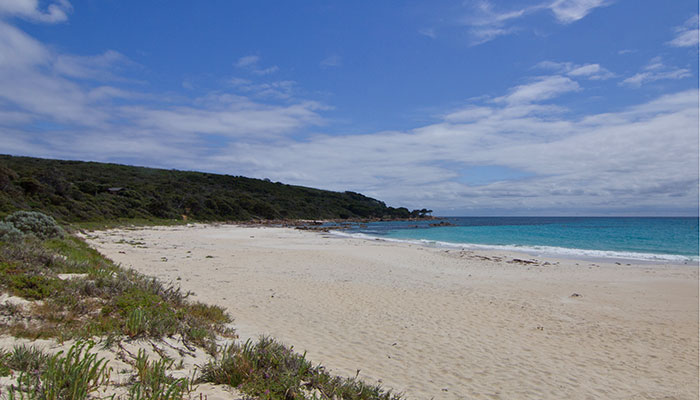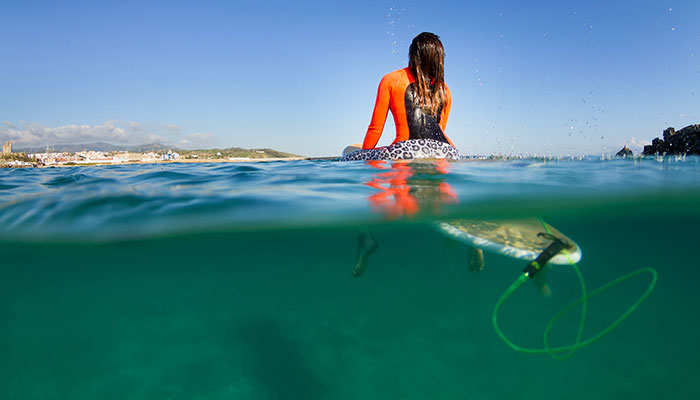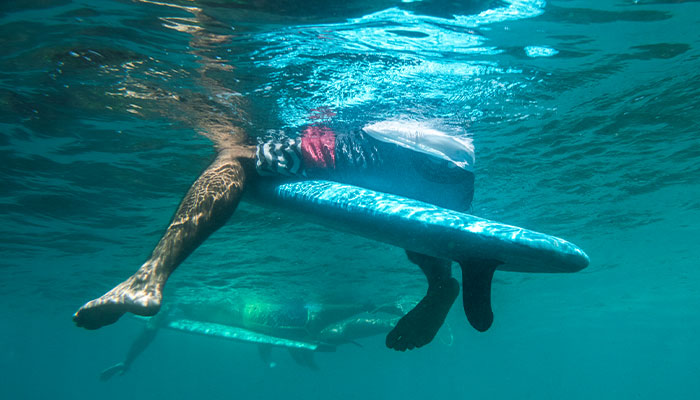Western Australia was reeling from a series of fatal shark attacks on surfers, swimmers and scuba divers when Dr Nathan Hart teamed up with a marine technology company to develop, with the support of WA government funding, a shark-deterrent wetsuit.

Making waves: Dr Nathan Hart is a specialist in visual neuroscience.
Hart, now an Associate Professor of Comparative Neurophysiology at Macquarie University, had established in 2011 that sharks have only one type of cone in their retinas and are therefore likely to be completely colour blind – a surprising discovery, given the vast majority of the other fish in the sea have colour vision.
Cones are photoreceptors that allow animals to perceive colour, and cone monochromat creatures – those with a single cone type – see in black and white. This means sharks probably see their world in shades of grey and the resulting wetsuits work on the principle that their wearers will blend into the underwater background, making them difficult for sharks to see.
“It helps to break up the person’s silhouette and their outline under water, just the same way that army camouflage does for people on land, but from the point of view of a shark looking, rather than a human looking,” says Hart, a specialist in visual neuroscience.
“It makes people look less like a solid object that a shark then wants to go and investigate.”
As well as camouflage wetsuits, which are in contrasting shades of blue, Hart helped the company, Perth-based Smart Marine Systems, develop a striped black-and-white design that effects the look of a sea snake, a banded creature which, anecdotal evidence suggests, some shark species prefer to avoid.
Sharks definitely respond differently to the camouflaged pattern. If I was a mad keen scuba diver, I’d buy one
While the company has sold hundreds of wetsuits since their 2013 launch, their true effectiveness at deterring sharks is virtually impossible to establish due to the obvious issues involved with testing in the field.
“We ran out of student volunteers very quickly,” Hart jokes.
But seriously, “You’re never going to be able to do a controlled experiment with the full wetsuit for a number of reasons: getting approval from state regulatory bodies to conduct an experiment where you have a human-identical dummy in the water dressed in a wetsuit and which you try and encourage sharks to go and bite, is extremely unlikely.
“We just wouldn’t want to encourage sharks to associate people in wetsuits with food.”
- Bright idea: Lights under boards may hide surfers from sharks
- From sea monsters to BFFs: the amazing mateship of sharks
Instead, an alternative testing method was used that involved putting tuna heads inside two non-humanoid barrels wrapped in wetsuit material, one the traditional black neoprene, the other the camouflage design.
“A tiger shark came in and nailed the black wetsuit, whereas there was a delay of several minutes in its approach to the other one, and that’s enough time for you to get out of the water,” Hart says.
“Really no one knows why a shark, which is a very complex animal, will target one person and not another in the water and it’s really difficult to say [the wetsuit] is 100 per cent working but the idea is that this is being designed from first principles and, based on that testing that’s been done, sharks definitely respond differently to the camouflaged pattern. If I was a mad keen scuba diver, I’d buy one.”

Lives lost: Bunker Bay, WA, where 21 year-old Kyle James Burden was killed in a shark attack while bodyboarding in 2011.
One person on average dies every year in Australia from shark attack, says Hart; statistically, people have more chance of dying while taking a selfie. But regardless of the slim odds, the political and emotional impacts of shark attacks are enormous.
Anything to end the trauma
“You see the trauma that is caused, not just to the poor person that gets bitten but the whole community; some of these seaside towns just get devastated,” says Hart.
“And then there’s the split view that emerges – one group of people who say we’re in the shark’s habitat so we can’t blame them, and the other saying we need to kill a few more sharks to make us safer in the water.
“I understand both perspectives, but if we can avoid all that heartache and be a bit more clever about how we do things ... In the end, if all of this saves even just one person’s life, it makes it worthwhile.”
Read Associate Professor Hart's research paper on colourblindness in sharks.



